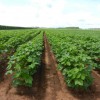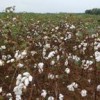Insect and mite pests of cotton feed on cotton roots, leaves, stems, and fruit and reduce plant health and productivity, and, subsequently, cotton crop yields. These pests hide in different places on or within the plant or field, which makes them difficult to find and identify and costly to manage. The purpose of this 14-page guide written by Joseph Funderburk, Nicole Casuso, Norman Leppla, and Michael Donahoe and published by the Department of Entomology and Nematology is to provide Florida cotton growers a selected set of options for integrated pest management of insects and mites in cotton fields. It serves as a reference for cultural, mechanical, biological, and chemical control of arthropods. The guide includes links to additional UF/IFAS EDIS articles, as well as external sources of information on arthropod management. The guide also contains a searchable table of registered insecticides, herbicides, and fungicides for Florida cotton.
edis.ifas.ufl.edu/in1111
Tag: Michael Donahoe
Integrated Pest Management for Mosquito Reduction around Homes and Neighborhoods
 This 40-page publication describes how homeowners can use an integrated pest management (IPM) program to help decrease pesticide use, reduce the risk of contracting mosquito-borne diseases, and ease the financial burden on local governments responsible for area-wide control. Modern mosquito control emphasizes source reduction to eliminate areas where mosquitoes thrive; surveillance to determine whether pesticide applications are necessary; screening; sanitation; and other techniques described in this document. The methods recommended in this publication are particularly effective in reducing mosquitoes that transmit diseases. Homeowners who take responsibility for identifying and eliminating sources of mosquito production around their homes and neighborhoods will improve health and quality of life for all Florida residents. Written by C. R. Connelly, E. Bolles, D. Culbert, J. DeValerio, M. Donahoe, K. Gabel, R. Jordi, J. McLaughlin, A. S. Neal, S. Scalera, E. Toro, and J. Walter, and published by the UF Department of Entomology and Nematology, September 2014.
This 40-page publication describes how homeowners can use an integrated pest management (IPM) program to help decrease pesticide use, reduce the risk of contracting mosquito-borne diseases, and ease the financial burden on local governments responsible for area-wide control. Modern mosquito control emphasizes source reduction to eliminate areas where mosquitoes thrive; surveillance to determine whether pesticide applications are necessary; screening; sanitation; and other techniques described in this document. The methods recommended in this publication are particularly effective in reducing mosquitoes that transmit diseases. Homeowners who take responsibility for identifying and eliminating sources of mosquito production around their homes and neighborhoods will improve health and quality of life for all Florida residents. Written by C. R. Connelly, E. Bolles, D. Culbert, J. DeValerio, M. Donahoe, K. Gabel, R. Jordi, J. McLaughlin, A. S. Neal, S. Scalera, E. Toro, and J. Walter, and published by the UF Department of Entomology and Nematology, September 2014.
http://edis.ifas.ufl.edu/in1045
2013 Evaluation of Non-Irrigated Early-Maturing Cotton Varieties in Jay, Florida
 This report includes a summary of the 2013 early-season cotton Official Variety Trial in Jay, Florida. It shows the performance of 11 cotton varieties. This data represents only one year and one location, and readers are cautioned that test results should be considered over several locations and years before final conclusions are valid. This 5-page fact sheet was written by Darcy Telenko and Michael Donahoe , and published by the UF Department of Agronomy, January 2014.
This report includes a summary of the 2013 early-season cotton Official Variety Trial in Jay, Florida. It shows the performance of 11 cotton varieties. This data represents only one year and one location, and readers are cautioned that test results should be considered over several locations and years before final conclusions are valid. This 5-page fact sheet was written by Darcy Telenko and Michael Donahoe , and published by the UF Department of Agronomy, January 2014.
http://edis.ifas.ufl.edu/ag378
2013 Evaluation of Non-Irrigated Mid- to Full-Season Maturing Cotton Varieties in Jay, Florida
 This report includes a summary of the 2013 mid- to full-season cotton Official Variety Trial in Jay, Florida. It shows the performance of 16 cotton varieties. This data represents only one year and one location, and readers are cautioned that test results should be considered over several locations and years before final conclusions are valid. This 5-page fact sheet was written by Darcy E. P. Telenko and Michael Donahoe, and published by the UF Department of Agronomy, January 2014.
This report includes a summary of the 2013 mid- to full-season cotton Official Variety Trial in Jay, Florida. It shows the performance of 16 cotton varieties. This data represents only one year and one location, and readers are cautioned that test results should be considered over several locations and years before final conclusions are valid. This 5-page fact sheet was written by Darcy E. P. Telenko and Michael Donahoe, and published by the UF Department of Agronomy, January 2014.
http://edis.ifas.ufl.edu/ag377
